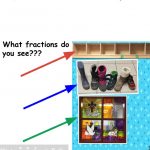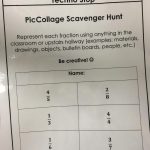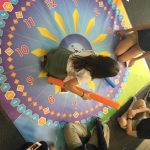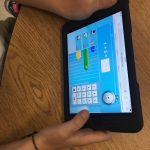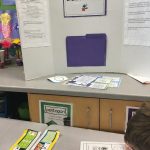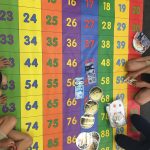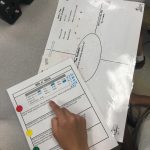We explored and developed effective strategies to increase student confidence and competence in math through peer mentorship. We partnered Grade 3 students with Grade 6 students in order to build skill and develop independence for both grade levels. Our older students assumed the role of “experts” and provided one-to-one skill building and coaching for our younger students. The learning was reciprocal as the “Learning Buddies” explored the different math strands through collaborative problem-solving and interactive math play/stations. The older students were also able to review concepts from earlier grades to scaffold current learning. Using Chromebooks to enhance our 21st century learning, we were provided with an additional online platform to build basic skills and develop digital literacy.
Team Members
Maria Minten Taylor
London District Catholic School Board
Heather Murphy
London District Catholic School Board
Professional Learning Goals
We brainstormed and developed an effective “Learning Buddies” mentorship approach between our Grade 3 and 6 students. We increased our understanding of a truly differentiated classroom modelled in a Guided, Shared and Independent Math approach, as well as increased confidence in our ability to teach math differently.
We were able to reflect closely on the curriculum expectations and the big ideas of each strand in order to better understand how we needed to progress to move students ahead in their learning.
Using a variety of resources and through reflective practice, we focused on developing a model to provide multiple entry points through scaffolding for all learners.
Activities and Resources
We began by creating our Grade 3/6 partnerships and provided some initial opportunities for them to engage and build rapport with one another. Secondly, we used release time to conduct research, brainstorm ideas and create a working model for our Learning Buddies. We focused on using our shared math time to incorporate collaborative, hands-on activities that allow both buddies to be actively involved.
We created a template to scaffold learning around specific topics within the math strand. We selected appropriate questions in a levelled way to allow students to naturally move forward in their learning. All student work was done with washable marker on laminated sheets.
We began a process of implementing/testing and reflecting on our practice as we started using our math centres with the Learning Buddies. After tweaking our practice, we moved towards a Centres-Based Learning Buddies Model where Grade 3 students will move through a variety of centres while the Grade 6 mentors became “station experts” to guide and coach more effectively.
Our final Centres included:
Techno Stop: Students used the Chromebooks or iPads for math activities/tasks (Mathletics, Pic Collage, etc)
Keeping it Real: Open-ended, real-life math problems
WIK/WINK (What I Know/What I Need to Know): Problem-solving with a explicitly taught problem-solving model (with work mat)
Active Math: Using Jump2Math mats, students were up and moving while learning
Math Cardio and Math Brain Stretches: Two stations with worksheet type questions to build basic skills (stations would have the required manipulatives, etc. for students to use)
Games: Concept-driven math games
Resources:
Mathletics, Jump2math, Guide to Effective Introduction in Math, EduGAINS as well as a variety of math games and manipulatives
Unexpected Challenges
Our main unexpected challenge was how to effectively rotate the mentors and buddies through the centres. We wanted everyone to stay engaged and active in the learning. Our first attempt at stations began well, but it became apparent by rotation three that the buddies where increasingly off-task. For our second attempt, we put the Grade 6 mentors as station experts and only rotated the Grade 3 students. This allowed the older students to become familiar and confident in their coaching. At this point, space became an issue (classroom size) so we invited a second Grade 3 class to participate and the Grade 6 students were evenly spread between the classes. This meant we had to come up with more materials faster. Eventually we settled on Grade 6 students rotating every third station while the Grade 3 students rotate every time. This alleviated off-task behaviour almost completely.
Enhancing Student Learning and Development
Through our partnerships, we built a foundation of confidence, collaboration and problem-solving skills. All students were far more confident in applying the skills and strategies needed to effectively attempt and solve problems. Math engagement was increased and students are enjoying math class and time spent with their peer mentors. This is reflected in their math scores.
Additionally, we have seen an improvement in learning skills and work habit for both grade levels, as well as an increase in leadership specifically for the Grade 6 mentors. These are transferable skills throughout all curriculum.
Sharing
We have been including a second Grade 3 class for some time – this is the beginning of our planning process to increase the number of involved classrooms for next year. We have invited curriculum support/math lead teachers to observe our students at work. We were able to share different elements of our learning and process throughout the duration of the project as many colleagues and other interested parties came to see what we were up to.
We have been compiling a collection of resources and templates to use in the future, as well as to share with our colleagues.
We have opened up our classroom to serve as a Demonstration Class.
Project Evaluation
We feel our project was a great success, meeting and exceeding our goals. As professionals, we are far more confident and knowledgeable in best practices for math teaching. Also, risk-taking is far less scary! This project has opened our eyes to a multitude of other possibilities to increase, improve and develop our planning for next year.
Students are engaged and this makes our teaching more meaningful, effective and enjoyable.
Resources Used
Mathletics (for tech-time, online practice, worksheets and rich tasks)
Pic Collage (an iPad app that allows students to make their thinking visual)
Guide to Effective Instruction in Math
http://www.edugains.ca/newsite/math/guides_effective_instruction.html
Jump2Math mats
Resources Created
These resources will open in your browser in a new tab, or be downloaded to your computer.


